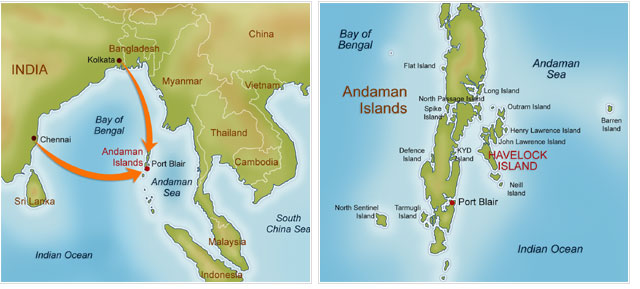
I mentioned that Dr. Anvita Abbi gave a great talk at the Himalayan Languages Symposium on her work on Great Andaman in the Indian Ocean. Here’s a map just to show you where that is. [Image credit: Barefoot Holidays]
It’s a pretty remote area. In fact, the Nicobar Islands to the south are completely closed to outsiders. When you consider that the speakers of Great Anadaman are down to a single location and the community is switching to Hindi and English as a means of communication, the closed nature of the Nicobar Islands seems somewhat justified. Great Andamanese is actually 10 languages, of which 4 were documented by Dr. Abbi and are spoken by only a handful of speakers. I’ll let you check out more about that on this site.
One of the reasons it was fascinating to hear about was because of the highly-developed gender system based on a conceptualization of the world in relation to the human body. Generally, the kind of gender in languages that people are familiar with is that found in Romance languages, where nouns are marked as masculine or feminine, and verbs agree with nouns so that you know which noun is ‘controlling’ the action (it’s more complicated than that of course, but this is just to illustrate a point).
However, gender is simply a noun class system, and nouns can have as many classes as a language (or speakers of a language) find(s) useful. So German has three noun classes (masculine, feminine, neuter), and Bantu languages have a ton (help me out Bantu language experts), and other languages have noun classes based on living things, non-living things, plants, humans, tools, certain kinds of animals, etc..
What is interesting about Great Andamanese is that the same class markers are used on both nouns and verbs in a highly productive way (meaning that they seem to apply in all sorts of ways to both verbs and nouns). These noun class markers identify actions (such as going and coming) as related to one of 7 or so body part prefixes (which also classify nouns) depending on whether the action is conceptualized as relating to mouth (being ingested, digested, etc.. i.e. thinking or being beautiful), or moving in a certain manner (feet), and there are conceptualizations related to all sorts of body parts. Unfortunately I don’t have all my notes with me, as I just flew to the US for my brother’s wedding, but it’s really interesting to think of how this language connects (or doesn’t connect) to languages in Southeast Asia and Africa. Read up more on this fascinating system here, and check out Dr. Abbi’s new grammar of Great Andamanese, recently published by Brill.